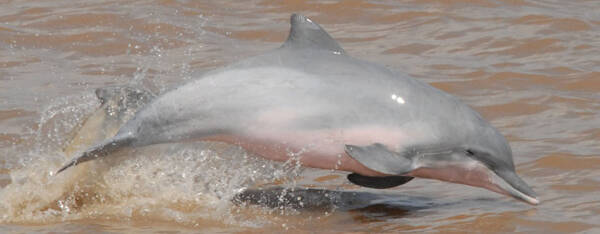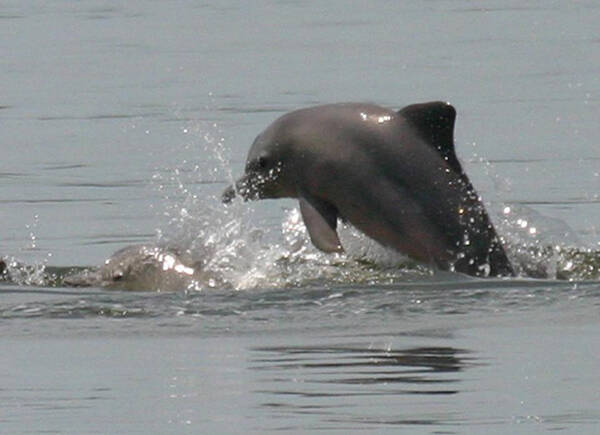Sotalia fluviatilis
IUCN
LCBasic Information
Scientific classification
- name:Sotalia fluviatilis
- Scientific Name:South American long-beaked dolphin, Amazon River white-sided dolphin
- Outline:Cetacea
- Family:Delphinidae G.P.w.dolphin
Vital signs
- length:86-206cm
- Weight:About 55kg
- lifetime:No verification information
Feature
The body is stout, the beak is prominent, and the forehead is slightly rounded.
Distribution and Habitat
Origin (water): Brazil, Colombia, Ecuador, Peru.
Inhabits three types of water in the Amazon Basin: rapids, clean water, and sewage. Tuku's dolphins seem to prefer main rivers and large lakes where access is not restricted by narrow or shallow channels. Do not generally enter flooded forests.
Appearance
The bill is long, with a bluish-grey, black or brownish-grey dorsal surface and a light grey, white or pink ventral surface. The melanin is slightly rounded. There is a dark stripe between the eye and the pectoral fin. The pectoral fins are broad and the same colour as the back. There are dark, backward stripes on the sides of the body. The dorsal fin is slightly curved backwards, with a broad base and the tip of the dorsal fin may have faded due to scraping the sea or riverbed. Some individuals may have a blunt tip. The caudal fin is broad and blunt at the end, with a concave rear edge and a prominent central notch. The back is bluish-grey or grey-brown. The abdomen is light grey, white or pink. Individuals and groups have a variety of colours; most fade with age.
There are 28-35/28-35 conical teeth on each side of the upper and lower jaws.
Size measurements: 71-106 cm when young. Adults are 86-206 cm long and weigh an average of 55 kg.
Distinctions: Tuku's dolphins may
Details
Tucuxi dolphin (scientific name: Sotalia fluviatilis) is also known as tucuxi in English. There is no subspecies.

Although they may let ships approach, most Tucuxi dolphins are wary of ships. They may ride on the waves caused by passing ships, but will not perform bow riding. Often seen peeping, tail slapping, pectoral slapping, and dolphin swimming (often in sync with other dolphins). Capable of leaping 1.2 meters out of the water (usually coming back down with a side slap), especially when startled. Dives are usually short (about 30 seconds), and rarely submerged for more than a minute. Very active when swimming; often seen in small groups, indicating strong social bonds. May feed with river dolphins, and in the Amazon River often with terns. Quieter when blowing than river dolphins. Tuku's dolphins usually float their heads and parts of their bodies out of the water when surfacing.
Tuku's dolphins swim slower than other dolphins, but are more active and rest for shorter periods of time. Males appear to swim in pairs with females. 55% of Tucu's dolphins form small groups of 1 to 6, and it is very rare for more than 9 to form a group. In the upper Amazon River, the average size of such groups is 3.9. In the Pacaya-Samiria Reserve in Peru, they usually move alone or in pairs. Large groups can cooperate in hunting, and the same species (members) communicate with whistles. Juvenile dolphins often appear in large groups, which may provide them with ample opportunities to learn various social activities.
Tucu's dolphins are carnivorous animals, mainly feeding on various ray-finned fish. The pH of the confluence area of rivers is conducive to the growth of plankton, which attracts various ray-finned fish. Tucu's dolphins often swim to the confluence area, probably looking for food.

The breeding season of Tuku dolphins is in late summer and early autumn. The female gestation period lasts 10 to 11.6 months. One calf is born per litter. The calf is born in the dry season in autumn. The newborn calf is about 71 to 106 cm long. Both sexes reach sexual maturity at the age of 6. Mature males are 180 cm long and females are about 160 cm long. Despite the slight difference in length, both sexes are roughly the same length and weight when grown. Little is known about parental care in tucuh dolphins, but it is known that females use whistles to contact their young when they find food. As mammals, females probably care for their young until the end of the lactation period.
An estimated 350 tucuh dolphins inhabit the Samiria River basin in Peru (Leatherwood 1996). The species has a moderate occurrence in the Peruvian Amazon, with 0.01-0.80/km² in river areas and 0.05-2.17/km² in lake areas. It is common in the Loreto and Tarapoto Rivers and Lago de Messenger in Colombia (da Silva and Best 1994). Along the 120 km stretch of the Amazon River in Colombia, Peru and Brazil, the 1993 estimate (Vidal et al. 1997) was 409 individuals (CV=13%). The density distribution (individuals/km²) is highest in the lake area at 8.6, 2.8 on the river bank and 2.0 on the island. The density is a small-scale estimate, not an overall assessment of the conservation status of the species.
Listed in Appendix II of the Convention on the Conservation of Migratory Species of Wild Animals (CMS). [2]
Listed in Appendix I of the Convention on International Trade in Endangered Species of Wild Fauna and Flora (CITES).
Listed in the IUCN Red List of Threatened Species: Data Deficient (DD), assessed in 2010.
Listed in China's National Key Protected Wildlife List: National Class II Protected Animal (effective December 10, 1988, Cetacean*Other Cetaceans).
Protect wildlife and stop eating game.
Maintaining ecological balance is everyone's responsibility!








